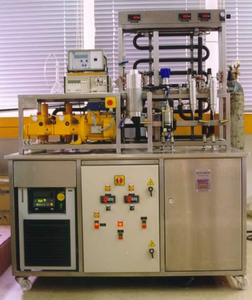 Supercritical fluid extraction (SFE) is a relatively new technique, mainly used for the separation/recovery of high added value compounds.
The most widely used solvent for SFE is CO2, which is considered as a "green solvent", being non-flammable and non-toxic. It is also readily available and inexpensive, and a very good and versatile solvent in supercritical conditions.
Despite its high investment cost, which is mainly due to the high operation pressures, SFE attracts more and more attention for the recovery of high valued, bio-active, and thermolabile products.
TTPL has significant experience in the area of SFE, both theoretical and experimental, having participated in various pertinent research projects. In the framework of such projects, experiments were conducted in the bench scale apparatus of TTPL (SFE-500, Separex), in order to examine the effect of various process parameters (pressure, temperature, solvent flow rate and particle size) in the recovery of essential oils and antioxidants from various raw materials, e.g. celery, parsley, pepper, dittany, and red grape marc. Process modelling was also realized by employing suitable mass transfer and empirical thermodynamic models. The results of these studies were utilized for the scale-up and design of an industrial SFE unit in collaboration with VIORYL SA.
Supercritical fluid extraction (SFE) is a relatively new technique, mainly used for the separation/recovery of high added value compounds.
The most widely used solvent for SFE is CO2, which is considered as a "green solvent", being non-flammable and non-toxic. It is also readily available and inexpensive, and a very good and versatile solvent in supercritical conditions.
Despite its high investment cost, which is mainly due to the high operation pressures, SFE attracts more and more attention for the recovery of high valued, bio-active, and thermolabile products.
TTPL has significant experience in the area of SFE, both theoretical and experimental, having participated in various pertinent research projects. In the framework of such projects, experiments were conducted in the bench scale apparatus of TTPL (SFE-500, Separex), in order to examine the effect of various process parameters (pressure, temperature, solvent flow rate and particle size) in the recovery of essential oils and antioxidants from various raw materials, e.g. celery, parsley, pepper, dittany, and red grape marc. Process modelling was also realized by employing suitable mass transfer and empirical thermodynamic models. The results of these studies were utilized for the scale-up and design of an industrial SFE unit in collaboration with VIORYL SA.
Selected publications:
- Lemonis I., Tsimogiannis D., Louli V Voutsas E., Oreopoulou V., Magoulas K, Extraction of Dittany (Origanum dictamnus) using supercritical CO2 and liquid solvent, Journal of Supercritical Fluids, 76, 2013, 48-53.
- Papamichail I., Louli V., Magoulas K., Supercritical fluid extraction of celery seed oil, Journal of Supercritical Fluids, 18(3), 2000, 213-226.
- Louli V., Folas G., Voutsas E., Magoulas K., Extraction of Parsley Seed Oil by Supercritical CO2, J. Supercritical Fluids, 30, 2004, 163.

